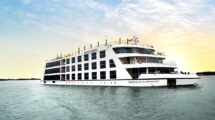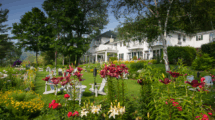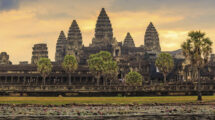
Story and photos by Ann-Maureen Owens
Snowbirds gather in numbers to enjoy the seaside resorts of Sicily
For both a winter escape and cultural experience, Sicily, with mild temperatures and numerous UNESCO World Heritage sites, is perfect. Over the centuries, it has been invaded by many different civilizations — Greeks, Carthaginians, Romans, Arabs, Normans, Spaniards, Bourbons, Italians, and WWII Allied Forces — and they all left something behind to interest the latest invasion of tourists. By visiting during winter or early spring, “snowbirds” can experience these sites at leisure, without the crowds and oppressive summer heat, and also enjoy outdoor cafes and sunny beach walks. Many attractions are quite inexpensive, and some give discounts to seniors.

Southeast Sicily
Seaside resorts can seem deserted in the offseason, but towns a bit inland pulse with local life. We were a party of four renting a small house for a month in Ragusa Ibla. Like nearby towns, Noto, Scicli, and Modica, Ragusa was rebuilt in the beautiful Baroque style after a massive earthquake in 1693. Half of the population chose to rebuild a well-ordered streetscape on the ridge above, while the other half renovated the old village, with its domed churches and narrow winding streets of clay roof-tiled buildings flowing down the sides of the cliff. Ambling around town means negotiating stone staircases to find excellent cafes, or shops for local ingredients to do your own Italian cooking.
Agriturismo Magazze, a farm restaurant about 20 kilometers southwest of Ragusa Ibla, provides a multicourse lunch or dinner and a close look at their herd of water buffalo before enjoying fresh buffalo mozzarella. Most of the dishes are farm-to-table fare. We were the only English speakers in the room, but with a set menu, nodding and smiling was sufficient.
On a day trip to the Valley of the Temples at Agrigento, we strolled the Via Sacra footpath from one Greek ruin to another in a rugged landscape overlooking the sea to one side and the modern city in the near distance on the other side. The Temple of Concord dates from 430 BC, but is fully intact because it was usurped for use as a Christian church for several centuries. Temples built to honour Hercules, Hera, and Zeus are even older and show the ravages of Carthaginian sieges and Roman occupation. In February, almond trees are in blossom, making the temples even more picturesque.
A drive into the hills near the town of Piazza Armerina, took us to the best preserved and most extensive Roman mosaics in the world at Villa Romani
Casale. Thought to have belonged to an important third-century Roman official, the villa’s floors were buried by a 12th century mudslide and only uncovered in the 1950s. The intricate mosaics portray sport and hunting scenes, along with exotic animals and glimpses of family life. On our return drive we stopped to take in views of Mount Etna, the active volcano about 100 km away.

Southeast Sicily has many sites associated with modern storyteller Andrea Camilleri’s detective, Inspector Montalbano. Though his novels are set in Agrigento, the long-running Italian TV series based on them, is filmed around Ragusa and nearby Scili and Punta Secca. We toured Castello di Donnafugata, filmed as the luxurious abode of Montalbano’s Mafia nemeses. There were views across the valley from the castle tower and a concrete maze to explore.
Siracusa
Siracusa, ancient seat of Greek wealth and power and home of famous mathematician, Archimedes, is a must-see. Taking a break from driving, we went by train and stayed overnight in the heart of the city’s oldest quarter, the island of Ortigia, though we had to search the narrow, atmospheric streets for the hotel, our rooms opened onto balconies with wide sea views.
Families fished and splashed in the water on Ortigia’s small, pebbly beaches as we walked along the breezy sea wall. The wide Piazza Duomo showcases an impressive Baroque cathedral (Duomo) incorporating Doric columns into its walls that can be seen from both inside and out. It was built over the Roman temple of Minerva, which in turn had been built around the Greek temple of Athena. Across the piazza is the church of Santa Lucia Alla Badia, where a famed Carravaggio painting, The Burial of St Lucy, is displayed.
At sundown, everyone is out for a walk — The Passeggiata — Sicily’s supreme activity. That’s the time to pick one of the cafe patios on Lungomare Alfeo for aperitifs, followed by seafood pasta, while watching the walkers and the sunset. The next day, we joined local shoppers and lunched on huge and delicious, made-to-order sandwiches in the exuberant openair Ortigia market.
We caught a bus from Ortigia to Parco Archeologico Neapolis, a site with impressive ancient Greek and Roman amphitheatres, and the cavern named “Ear of Dionysius” for the shape of its opening and its exceptional acoustics. It is the source of both mystical and unsavoury legends about captive slaves who were imprisoned here in ancient times.

Palermo
A four-hour drive from Ragusa, took us to Sicily’s capital, Palermo, with its beautiful Norman architecture, lively markets, and historic mix of cultures. We made sure to visit the Palazzo dei Normanni, seat of government since the time of Arab rule, and its well-preserved jewel of a chapel, Capella Palatina, a rich combination of western and Islamic elements.
In fact, the churches are where the intermingling of cultures that flourished under Norman control, is best exhibited. The roof of San Cataldo has three red domes and Arab-style parapets, Santa Maria
A few days before arriving in Palermo, we engaged a local guide for a walking tour of the city and he introduced us to markets, galleries, neighbourhoods, and many hidden gems that we would not have discovered on our own, such as the old Jewish quarter and buildings still un-repaired from WWII, as well as samplings of street food and Palermo’s best cannelloni shop. Teatro Massimo, the largest opera house in Italy, provided another worthwhile guided tour.
If your timing is right, you can attend a concert or opera performance in its opulent surroundings. We were not so lucky, but decided that sunset, viewed from our hotel roof-top bar overlooking the city and surrounding mountains was the best way to end a day.
IF YOU GO:
Flights from Toronto/Ottawa to Catania or Palermo will require transfers or layovers. We flew Air Canada to London and Easyjet to Catania but could have chosen any European city with direct connections.
Accommodation:
In Ragusa – Residenze Turistiche San Paolo via airbnb.ca
In Siracusa: Allegroitalia Ortigia Hotel via allegroitalia.it
In Palermo: Hotel Ambasciatori ambasciatorihotelpalermo.com
Palermo guide: Domenico Aronica palermowalkingtour.com
Eating out:
Regusa Ibla: Cantunera Ibla is a great place for arancini near the public gardens.
Ragusa area: Ristorante dell’Azienda Agricola Magazze is a farm restaurant at Agriturismo Magazze on SP 60. Call for reservations. magazze.com
Siracusa Ortigia: Sole e Luna is a “home restaurant” on the seafront. Google for directions.
Borderi is a very popular market stall. caseificioborderi.eu
Palermo: I Cucci in the Piazza Bologni icuccibistrorante.it
Ristorante Pizzeria Italia on Via Orologio ristoranteepizzeriaitalia.it






